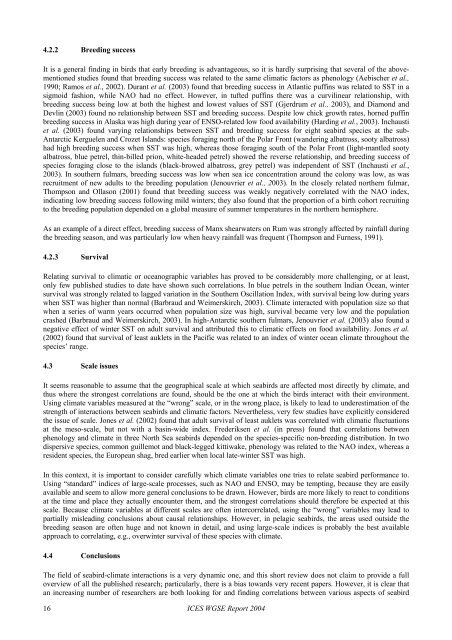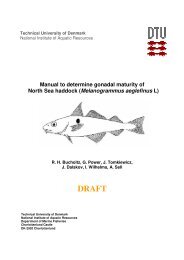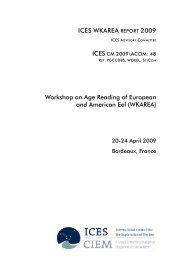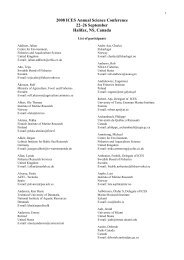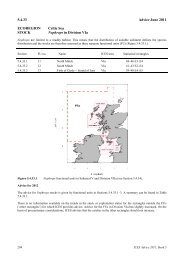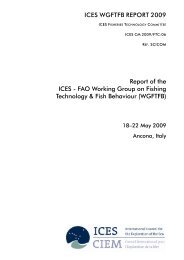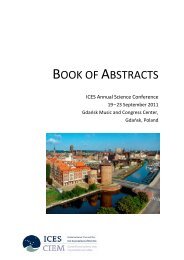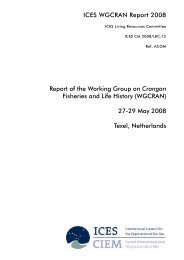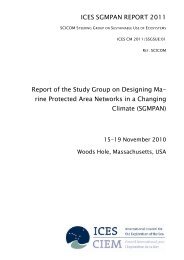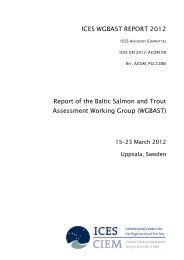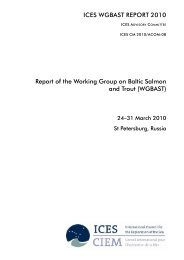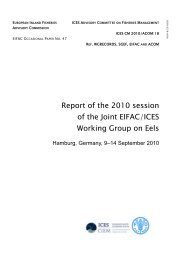Working Group on Seabird Ecology (WGSE). ICES CM 2004/C:05 ...
Working Group on Seabird Ecology (WGSE). ICES CM 2004/C:05 ...
Working Group on Seabird Ecology (WGSE). ICES CM 2004/C:05 ...
- TAGS
- seabird
- ecology
- ices
- www.ices.dk
You also want an ePaper? Increase the reach of your titles
YUMPU automatically turns print PDFs into web optimized ePapers that Google loves.
4.2.2 Breeding success<br />
It is a general finding in birds that early breeding is advantageous, so it is hardly surprising that several of the abovementi<strong>on</strong>ed<br />
studies found that breeding success was related to the same climatic factors as phenology (Aebischer et al.,<br />
1990; Ramos et al., 2002). Durant et al. (2003) found that breeding success in Atlantic puffins was related to SST in a<br />
sigmoid fashi<strong>on</strong>, while NAO had no effect. However, in tufted puffins there was a curvilinear relati<strong>on</strong>ship, with<br />
breeding success being low at both the highest and lowest values of SST (Gjerdrum et al., 2003), and Diam<strong>on</strong>d and<br />
Devlin (2003) found no relati<strong>on</strong>ship between SST and breeding success. Despite low chick growth rates, horned puffin<br />
breeding success in Alaska was high during year of ENSO-related low food availability (Harding et al., 2003). Inchausti<br />
et al. (2003) found varying relati<strong>on</strong>ships between SST and breeding success for eight seabird species at the sub-<br />
Antarctic Kerguelen and Crozet Islands: species foraging north of the Polar Fr<strong>on</strong>t (wandering albatross, sooty albatross)<br />
had high breeding success when SST was high, whereas those foraging south of the Polar Fr<strong>on</strong>t (light-mantled sooty<br />
albatross, blue petrel, thin-billed pri<strong>on</strong>, white-headed petrel) showed the reverse relati<strong>on</strong>ship, and breeding success of<br />
species foraging close to the islands (black-browed albatross, grey petrel) was independent of SST (Inchausti et al.,<br />
2003). In southern fulmars, breeding success was low when sea ice c<strong>on</strong>centrati<strong>on</strong> around the col<strong>on</strong>y was low, as was<br />
recruitment of new adults to the breeding populati<strong>on</strong> (Jenouvrier et al., 2003). In the closely related northern fulmar,<br />
Thomps<strong>on</strong> and Ollas<strong>on</strong> (2001) found that breeding success was weakly negatively correlated with the NAO index,<br />
indicating low breeding success following mild winters; they also found that the proporti<strong>on</strong> of a birth cohort recruiting<br />
to the breeding populati<strong>on</strong> depended <strong>on</strong> a global measure of summer temperatures in the northern hemisphere.<br />
As an example of a direct effect, breeding success of Manx shearwaters <strong>on</strong> Rum was str<strong>on</strong>gly affected by rainfall during<br />
the breeding seas<strong>on</strong>, and was particularly low when heavy rainfall was frequent (Thomps<strong>on</strong> and Furness, 1991).<br />
4.2.3 Survival<br />
Relating survival to climatic or oceanographic variables has proved to be c<strong>on</strong>siderably more challenging, or at least,<br />
<strong>on</strong>ly few published studies to date have shown such correlati<strong>on</strong>s. In blue petrels in the southern Indian Ocean, winter<br />
survival was str<strong>on</strong>gly related to lagged variati<strong>on</strong> in the Southern Oscillati<strong>on</strong> Index, with survival being low during years<br />
when SST was higher than normal (Barbraud and Weimerskirch, 2003). Climate interacted with populati<strong>on</strong> size so that<br />
when a series of warm years occurred when populati<strong>on</strong> size was high, survival became very low and the populati<strong>on</strong><br />
crashed (Barbraud and Weimerskirch, 2003). In high-Antarctic southern fulmars, Jenouvrier et al. (2003) also found a<br />
negative effect of winter SST <strong>on</strong> adult survival and attributed this to climatic effects <strong>on</strong> food availability. J<strong>on</strong>es et al.<br />
(2002) found that survival of least auklets in the Pacific was related to an index of winter ocean climate throughout the<br />
species’ range.<br />
4.3 Scale issues<br />
It seems reas<strong>on</strong>able to assume that the geographical scale at which seabirds are affected most directly by climate, and<br />
thus where the str<strong>on</strong>gest correlati<strong>on</strong>s are found, should be the <strong>on</strong>e at which the birds interact with their envir<strong>on</strong>ment.<br />
Using climate variables measured at the “wr<strong>on</strong>g” scale, or in the wr<strong>on</strong>g place, is likely to lead to underestimati<strong>on</strong> of the<br />
strength of interacti<strong>on</strong>s between seabirds and climatic factors. Nevertheless, very few studies have explicitly c<strong>on</strong>sidered<br />
the issue of scale. J<strong>on</strong>es et al. (2002) found that adult survival of least auklets was correlated with climatic fluctuati<strong>on</strong>s<br />
at the meso-scale, but not with a basin-wide index. Frederiksen et al. (in press) found that correlati<strong>on</strong>s between<br />
phenology and climate in three North Sea seabirds depended <strong>on</strong> the species-specific n<strong>on</strong>-breeding distributi<strong>on</strong>. In two<br />
dispersive species, comm<strong>on</strong> guillemot and black-legged kittiwake, phenology was related to the NAO index, whereas a<br />
resident species, the European shag, bred earlier when local late-winter SST was high.<br />
In this c<strong>on</strong>text, it is important to c<strong>on</strong>sider carefully which climate variables <strong>on</strong>e tries to relate seabird performance to.<br />
Using “standard” indices of large-scale processes, such as NAO and ENSO, may be tempting, because they are easily<br />
available and seem to allow more general c<strong>on</strong>clusi<strong>on</strong>s to be drawn. However, birds are more likely to react to c<strong>on</strong>diti<strong>on</strong>s<br />
at the time and place they actually encounter them, and the str<strong>on</strong>gest correlati<strong>on</strong>s should therefore be expected at this<br />
scale. Because climate variables at different scales are often intercorrelated, using the “wr<strong>on</strong>g” variables may lead to<br />
partially misleading c<strong>on</strong>clusi<strong>on</strong>s about causal relati<strong>on</strong>ships. However, in pelagic seabirds, the areas used outside the<br />
breeding seas<strong>on</strong> are often huge and not known in detail, and using large-scale indices is probably the best available<br />
approach to correlating, e.g., overwinter survival of these species with climate.<br />
4.4 C<strong>on</strong>clusi<strong>on</strong>s<br />
The field of seabird-climate interacti<strong>on</strong>s is a very dynamic <strong>on</strong>e, and this short review does not claim to provide a full<br />
overview of all the published research; particularly, there is a bias towards very recent papers. However, it is clear that<br />
an increasing number of researchers are both looking for and finding correlati<strong>on</strong>s between various aspects of seabird<br />
16<br />
<strong>ICES</strong> <strong>WGSE</strong> Report <strong>2004</strong>


